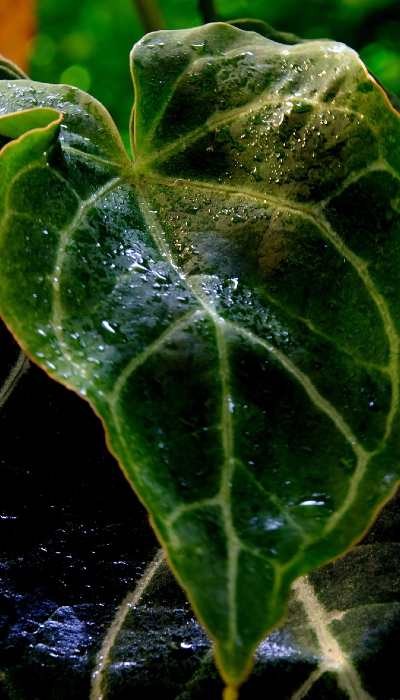Anthurium crystallinum, also known as the crystalline anthurium, has many of the same growing requirements as other members of the anthurium family.
This plant grows in the U.S. Department of Agriculture hardiness zones 10 through 12 and requires high humidity, moist soil, and bright light to grow well indoors. If you want to try growing this flower as a houseplant, here’s how to care for it properly.

What Is an Anthurium?
Anthuriums are a genus of about 850 species of flowering plants, belonging to the family Araceae. The name is derived from the Ancient Greek ἄνθος (flower) and ῥύστης (rose). They are native mostly to tropical regions with wet climates and are often found in forests or near streams. Although they do not have any thorns on them, they still need protection from sunlight as they can get sunburned.
Anthuriums produce flowers that can be either solitary or in clusters on the crown (the top part) of the plant. Flowers come in many colors and shapes: most are red but pink, white, orange, yellow, and purple flowers also exist.
Soil And Light

Anthurium crystallinum plants need well-drained soil with a pH of 5.5-7 and light to grow. The plant is best grown in pots that are about 10 inches wide and deep, but the plant can also be grown in baskets or hanging containers. In order for the plant not to become root bound (when roots have no more space) it should be transplanted every 3 months.
The potting mix should be made up of one part peat moss, one part perlite, and one part sand. Place the potting mix into the container so it covers the surface by about two inches then water thoroughly until water seeps from the drainage hole at the bottom of your pot. Add or remove some of the soil as needed so there’s room for the plant to grow.
Be sure you don’t overwater the plant because this will make the topsoil too wet and promote fungus growth which will affect root development. After planting, keep watering regularly but don’t overdo it because moist soil will create conditions where fungi will thrive on top of healthy roots.
It’s important that when you transplant a new Anthurium crystalinum plant you wait about three weeks before fertilizing again because this will allow time for new roots to form and help avoid transplant shock which could lead to yellowing leaves and stunted growth.
Watering
Anthuriums are popular plants in homes. If you have one, you may want to know how often it needs water and whether or not it needs fertilizer. Once the plant is mature, you can usually tell when it needs water because its leaves will start to droop. To make sure your plant has enough water, wait for its leaves to droop before watering it again.
The frequency of watering depends on how much sunlight the plant gets, but a general rule of thumb is that you should give your plant a thorough soak every three or four days if there isn’t much sun. You don’t need to fertilize your plant unless you want faster growth. Fertilizing once or twice a month is enough to keep it healthy.
Fertilizing
Anthuriums require a regular application of fertilizer during the growing season (March through October). To fertilize, first water the plant thoroughly and allow it to drain. Apply a solution of water and fertilizer at half strength, using one teaspoon of fertilizer per quart of water.
Pour this solution directly onto the soil near the plant’s roots. Do not use too much, as this can lead to fertilizer burn. For best results, fertilize on a monthly basis for plants in pots and bonsai; for plants in hanging baskets or those placed outdoors in beds or containers, fertilize every two weeks.
Pests And Diseases
Anthuriums are a popular house plant that has several desirable attributes, including their ability to thrive under low light and in humid environments. However, there are some potential risks associated with growing this plant indoors. Anthuriums can be susceptible to certain pests and diseases, so it is important to be aware of the symptoms that should be monitored on a regular basis.
The most common pest found on anthurium plants is aphids. These insects suck sap from the leaves of the plant and can cause damage if they are left unchecked; they may also introduce viruses into your plant. Aphids will also secrete honeydew as they feed which can lead to a build-up of mold or fungus. When removing these pests, it is best to wipe them off using a damp cloth or cotton swab dipped in rubbing alcohol.
Another pest that can wreak havoc on anthurium plants is mealybugs. Mealybugs are tiny creatures covered with white waxy filaments and have the potential to release toxins that will eventually kill your plant if not removed promptly.
Caring For Your New Plant

Anthurium plants are known for their beautiful flowers, but they also make lovely house plants. This easy-care plant is perfect for beginners and can grow in either low light or bright light. Here’s how to care for your new plant:
- When you first bring your plant home, water it thoroughly so the soil is moist but not soggy.
- Place it in a bright location with filtered sunlight or low light and mist it occasionally if the leaves start to look dry or dusty.
- Keep the soil evenly moist at all times and fertilize every two weeks with a liquid fertilizer diluted according to package directions (or use slow-release fertilizer pellets).
- Pinch off spent flower spikes when the blossoms fade to encourage more blooms.
- If the leaves turn yellow and drop from the stem, cut back on watering until they return to a healthy green color; too much water can cause them to rot away.
- Cut back on watering if brown patches appear on the stems or if any black spots appear on the foliage–this means that too much moisture is accumulating around its roots. The ideal humidity level for this plant is 50%-60%. Do not allow the pot to sit in a saucer of water as this will likely cause root rot. As long as you follow these simple steps, your ornamental flowering plant should remain healthy and thrive!
Conclusion
Anthurium crystallinum plants are one of the most commonly found plants in the United States. They typically grow from a single stalk, with long leathery leaves and beautiful flowers, which can be either pink or purple. These plants require very little upkeep, making them the perfect addition to any home.
Anthurium crystallinum plants are easy to grow and maintain. They thrive in areas that are warm year-round, but they can also survive cold temperatures as low as 40 degrees Fahrenheit when they have enough light. It is important that they receive plenty of water during the growing season and be kept moist at all times while dormant in order for them not to wither away.
Also, check out the latest articles “Polka dot plant” and “Pink princess philodendron“
Hi I’m Bilal Malik, a digital marketing and blogging expert holding years of experience.










